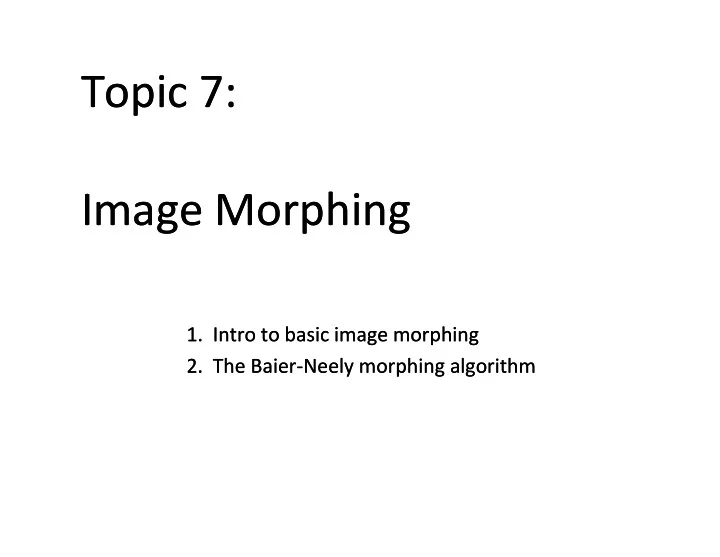

Topic 7: Topic 7: Image Morphing Image Morphing 1. 1. Intro to basic image morphing Intro to basic image morphing 2. 2. The Baier The Baier- -Neely morphing algorithm Neely morphing algorithm
Image Morphing Image Morphing Introduction to image morphing • Basic idea • Beier-Neely morphing
Extensions: View Morphing Extensions: View Morphing A combination of view synthesis & image morphing
Image Morphing Image Morphing A combination of generalized image warping with a cross-dissolve between pixels Morphing involves two steps: • Pre-warp the two images • Cross-dissolve their colors Source 1 Source 1 Image 0 Warp 0 Warp 1 Image 1 Morph Source 1 Source 1
Cross Cross- -Dissolving Two Images Dissolving Two Images Cross-dissolve A weighted combination of two images, pixel-by-pixel Image 0 Image 1 Combination controlled by a single interpolation parameter t:
Image Pre Image Pre- -Warping Warping Source 1 Source 1 Image 0 Warp 0 No pre-warping Pre-warping Warp 1 Image 1 Why warp first? In order to align features that appear in both images In order to align features that appear in both images (e.g., eyes, mouth, hair, etc). Without such an alignment, we would get a “double-image” effect!! Image pre-warping Re-position all pixels in the source images to avoid the “double- image” effect as much as possible Pre-warping implemented using the Field Morphing Algorithm
Image Morphing Image Morphing Both morphing steps specified by same parameter t • Warp the two images according to t • Cross-dissolve their colors according to t Morphing videos generated by creating a sequence of images, defined by a sequence of t-values (e.g., 0,0.1,0.2,…,0.9,1) defined by a sequence of t-values (e.g., 0,0.1,0.2,…,0.9,1) Source 1 Source 1 Source 0 Warp 0 Warp 1 Source 1
Morphing Example Morphing Example Image 0 Intermediate Images Image 1
Beier Beier- -Neely Field Morphing Algorithm (1992) Neely Field Morphing Algorithm (1992) Warped image computed using Field Morphing Algorithm Image warp specified by interactively drawing lines in the two source images
Morphing by Backward Mapping Morphing by Backward Mapping To completely determine the morph we need to define the functions U(r,c), V(r,c) Backward mapping: for r = rmin to rmax for c = cmin to cmax u = U(r,c) v = V(r,c) copy pixel at source (u,v) to destination (r,c)
Intermediate Morphs Intermediate Morphs A single parameter t defines two warps, one applied to image 1 and one to image 2 (r,c) (r,c)
Coordinate Maps in Field Morphing Coordinate Maps in Field Morphing Two cases: 1. Coordinate map defined by a single line pair 2. Coordinate map defined by multiple line pairs
Coordinate Maps from One Line Pair Coordinate Maps from One Line Pair Steps: 1. Compute position of pixel X in Image 1 relative to destination line (r,c) → (u,v) 2. Compute (r’,c’) coordinates of pixel X’ in Image 0 whose position relative to source line is (u,v) (u,v) → (r’,c’) (u,v) → (r’,c’) source line destination line
Computing Pixel Positions Relative to a Line Computing Pixel Positions Relative to a Line Position of pixel X in Image 1 relative to destination line (r,c) → (u,v) given by
Computing Pixel Positions Relative to a Line Computing Pixel Positions Relative to a Line Position of pixel X in Image 0 relative to source line (r,c) → (u,v)
Pixel Coordinates Relative to a Line Pixel Coordinates Relative to a Line Examples
Coordinate Maps from One Line Pair Coordinate Maps from One Line Pair Field warping algorithm (single-line case) For each pixel (r,c) in the destination image find the corresponding (u,v) coordinates of the pixel find the (r’,c’) in source image for that (u,v) color at destination pixel (r,c) = color at source pixel (r’,c’) r r’ c’ c
Coordinate Maps from Multiple Line Pairs Coordinate Maps from Multiple Line Pairs Field warping algorithm (multiple-line case) 1. Apply single-line field warping algorithm to each line separately, to get N source pixel positions (r i ’,c i ’) for every destination pixel (N= # of line pairs) 2. Compute source position (r’,c’) as weighted average of positions (r i ’,c i ’)
Computing the Averaging Weights Computing the Averaging Weights b p length (r,c) = weight + a dist < < abs ( v ) if 0 u 1 < distance of (r, c) from P if u 0 controls influence of line > distance of (r, c) from Q if u 1 for points near it
Beier Beier- -Neely Field Warping Algorithm Neely Field Warping Algorithm For each pixel (r,c) in destination image DSUM=(0,0) weightsum = 0 for each line (P i ,Q i ) calculate (u i ,v i ) based on P i ,Q i calculate (r i ’,c i ’) based on u,v & P i ’,Q i ’ based on u,v & P i ’,Q i ’ calculate displacement D i =X i ’-X i for this line calculate weight for line (P i ,Q i ) DSUM += Di*weight weightsum += weight (r’,c’) = (r,c) + DSUM/weightsum color at destination pixel (r,c) = color at source pixel (r’,c’)
Warping Example Warping Example
Morphing Example Morphing Example
Morphing Dynamic Scenes Morphing Dynamic Scenes
Recommend
More recommend